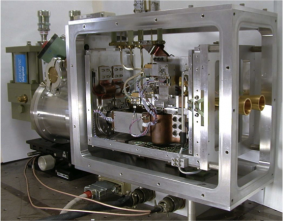
Redshift Search Receiver (RSR), the first-light wide-band 3 mm spectrograph currently installed on the LMT.
The Redshift Search Receiver (RSR) is a novel MMIC-based receiver (Erickson et al. 2007, ASP Conf. Series) designed to maximize the instantaneous receiver bandwidth to cover the 3mm wavelength atmospheric window (73-111 GHz) in a single tuning. The receiver has four pixels arranged in a dual-beam, dual polarized configuration (see Figures 1 and 2). Orthogonal polarizations are combined in waveguide-based orthomode transducers. Beam-switching at 1 kHz on the sky is achieved with a fast Faraday rotation polarization switch and a wire-grid to interchange the reflected and transmitted beams to each receiver (see Figure 1).

Figure 1: Block diagram view showing two beams on the sky. The orthogonal polarizations from both spots on the sky (see Figure 2) makes its way to 4 separate receiver outputs, and four independent spectral backends that produce 4 independent switched spectra that can be averaged together.

Figure 2: Beams are separated on the sky by ~78″ (~ 5 times HPBW). At any given instant, as the 1 kHz beam switch changes sign, the two orthogonal polarizations in each beam is received by four independent pixels. For more extended sources, there is a wide throw option which creates a spacing of 294″ between the beams.
This ultra-wideband receiver typically achieves noise temperatures < 50K between 73-111 GHz. Because of the fast beam-switch involving no moving mechanical parts, the Redshift Search Receiver has exceptional baseline stability, well-suited to the detection of redshifted transitions of the CO ladder from star-forming galaxies at cosmological distances. A innovative wideband analog autocorrelator system which covers the full 38 GHz with 31 MHz (100 km/s at 90 GHz) resolution serves as the backend spectrometer. The 38 GHz of total bandwidth is analyzed in 6 different slightly overlapping frequency bands (see Figure 3). Table 1 shows the salient characteristics of the RSR system. The RSR was commissioned on the FCRAO 14-m telescope in 2006, and in June 2011 it conducted the first-light scientific demonstration observations of the LMT.

Figure 3: The six different frequency bands of the RSR. Each band which is ~6.7 GHz wide is handled by a separate analog auto-correlation card. Four separate chassis handle the entire 38 GHz from each of the four RSR pixels.
Relevant information to be considered when requesting observing time with the RSR can be found it the RSR Observing Summary. RSR sensitivity and integration-time calculators, which consider the latest values of surface accuracy and efficiency of the 50m primary surface, are also available in LMT-Hedwig, the LMT’s proposal submission system.